Blagdon Lake Birds
April 2014 News
Tuesday 1st April [A beautiful spring day - at last!]
Not too much to report on the birding front. The 2♂♂ Long-tailed Ducks Clangula hyemalis are as difficult as ever. I spent 2 hours trying to get photos of them, but didn't even press the shutter and admit to giving up. I saw a couple of Sand Martins Riparia riparia fly through and the usual Lesser Black-backed Gulls Larus fuscus came in and washed up this afternoon in reasonable numbers, but they were the only new migrants that I was aware of.
Wednesday 2nd April [Sultry and still early morning]
The 2♂♂ Long-tailed Ducks Clangula hyemalis were feeding off Peg's Point this morning and there were 2 Little Egrets Egretta garzetta ranging around the lake. I thought the oppressive and overcast conditions might bring some more Little Gulls in, but no such luck and after an hour and a half I came home.
Joanna Dailey emailed this morning to say that white 'YA' the ♂ Osprey that caused all the excitement last year when he kept getting under the nets at Blagdon Pumping Station, has just landed back on his nest platform at Kielder Water in Northumberland, to be greeted by his mate from last year. What brilliant news! Joanna went on to report that his brother was trying to mate on YA’s nest with a Tweed Valley bird yesterday, but the normal order appears to have been restored today.
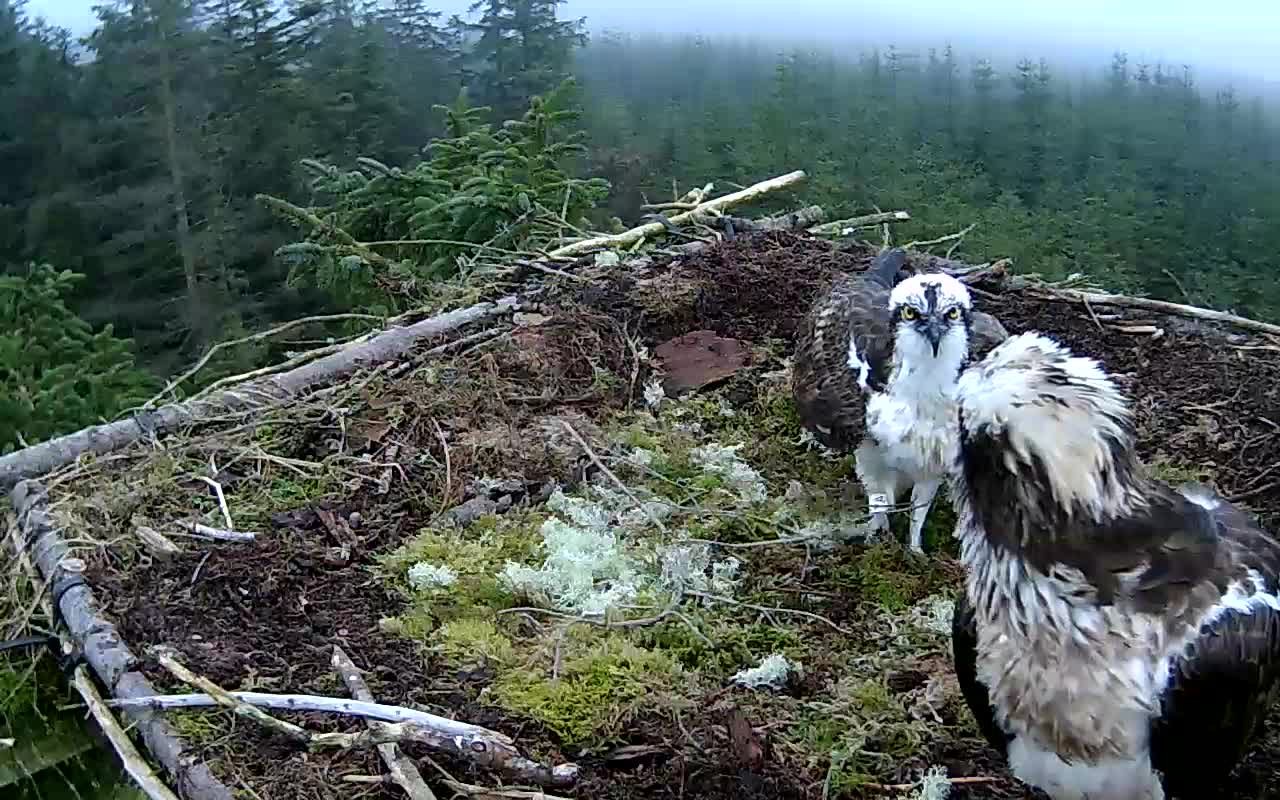 Male Osprey White 'YA' back at Kielder Water today © Forestry Commission, England, 2014
Male Osprey White 'YA' back at Kielder Water today © Forestry Commission, England, 2014
This afternoon, the Barn Owl box at Top End was replaced and a new one put up beside the old one on North Shore, just in case there are owls using it. Warwick White (BTO ringer) and I went to have a look a week or two ago, but the box was in such poor condition we couldn't check inside for fear of it falling to pieces altogether. Anyway, they have 2 new des res, so thanks to all those who paid to come to my winter talks which have part funded them, and to Paul Williams who made a very significant contribution to their cost. Finally, thanks to Keith and Linda at Specialised Nestboxes for making the boxes and Mike for helping to put them up. Great job!
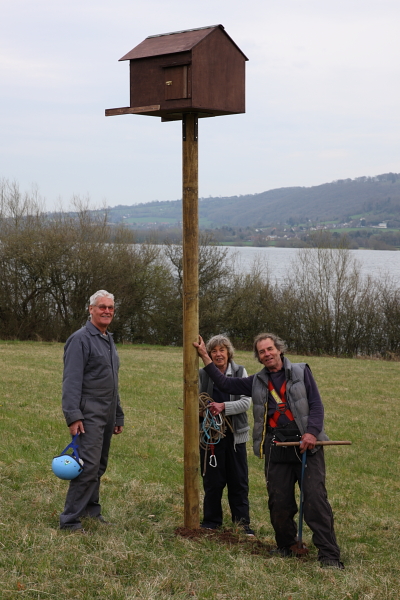
Thursday 3rd April [Mist all day with rain later]
I couldn't visit the lake until early evening, but I did manage to spot the 2♂♂ Long-tailed Ducks Clangula hyemalis off Wood Bay in the murk.
An Osprey Pandion haliaetus was noted by Dr. Alan Herring at 1530 hrs this afternoon. It was harrassed by Lesser-black Backed Gulls Larus fuscus and departed NE towards Butcombe.
Friday 4th April [Overcast, mild with a slight breeze]
The 2♂♂ Long-tailed Ducks Clangula hyemalis were off Wood Bay and the Common Sandpiper Actitis hypoleucos on the cill of the Spillway while I carried out my (April) Spring bird count this morning. Just as I had on 4th April last year I counted 28 Chiffchaffs Phylloscopus collybita singing, there were also 20 Blackcaps Sylvia atricapilla and 8 Willow Warblers Phylloscopus trochilus, neither of which were in on the same date last year. Of the residents, top count was 56 Winter Wrens Troglodytes troglodytes (cf. counts on 30th March). Oh, and I noticed a pair of (Western) Jackdaws Corvus monedula prospecting the Top End owl box already and needless to say, I saw no sign of the Osprey that showed up yesterday, during my 3 hour visit this morning.
This evening I saw an adult winter Little Gull Hydrocoloeus minutus feeding over the Dam End. While I was watching the Little Gull, 2 Common Shelducks Tadorna tadorna flew west. Then I carried out a bat transect from the dam around Butcombe Bay during which I saw lots of Noctules Nyctalus noctula foraging over and behind the dam in the failing daylight.
Saturday 5th April [Overcast, but mainly dry]
The 2♂♂ Long-tailed Ducks Clangula hyemalis are still favouring the area between Wood Bay and Rugmoor Point when they aren't being moved around by fishing boats. I spotted a small flock of circa 50 Sand Martins Riparia riparia feeding over Bell's Bush and careful scrutiny was eventually rewarded with my second Barn Swallow Hirundo rustica of the Spring among them.
I have just added a link to Birdgirl Mya-Rose Craig's blog under the title Young Birder on the links page and have to commend the excellent piece she has just written about the Spoon-billed Sandpiper, one of the world's rarer birds. I had the very good fortune to see as many as 9 together in a puddle on the Minjiang Estuary in Eastern China on 21st December 2009, an unforgettable experience and one I hope birders of the future will also have the same good fortune to witness. Let's hope Mya-Rose, and other youngsters like her, can make a difference for the good of the planet - it'll be a sadder place without such an iconic species.
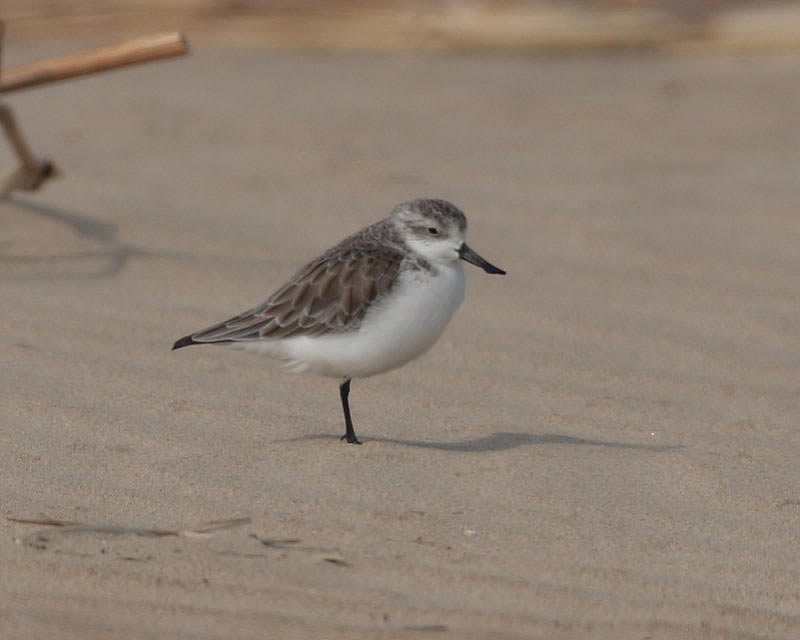
Sunday 6th April [Overcast, mild with showers]
We still have the 2♂♂ Long-tailed Ducks Clangula hyemalis on the lake and they even came close enough for me to grab some pictures late this afternoon in the drizzle. However, most exciting were the pair of Garganey Anas querquedula and a Green Sandpiper Tringa ochropus at Top End, two new species for the year, and the half dozen or so Barn Swallows Hirundo rustica among the Sand Martins Riparia riparia. I guess the southerly winds have been speeding them our way. Last year it took me until 15th April to reach 100 species at the lake, and at present I'm on 92 spp., but I've missed 3 and am currently 5 spp. behind where I was at the same time last year, despite the cold spring we experienced back then. Up early with the lark tomorrow then...
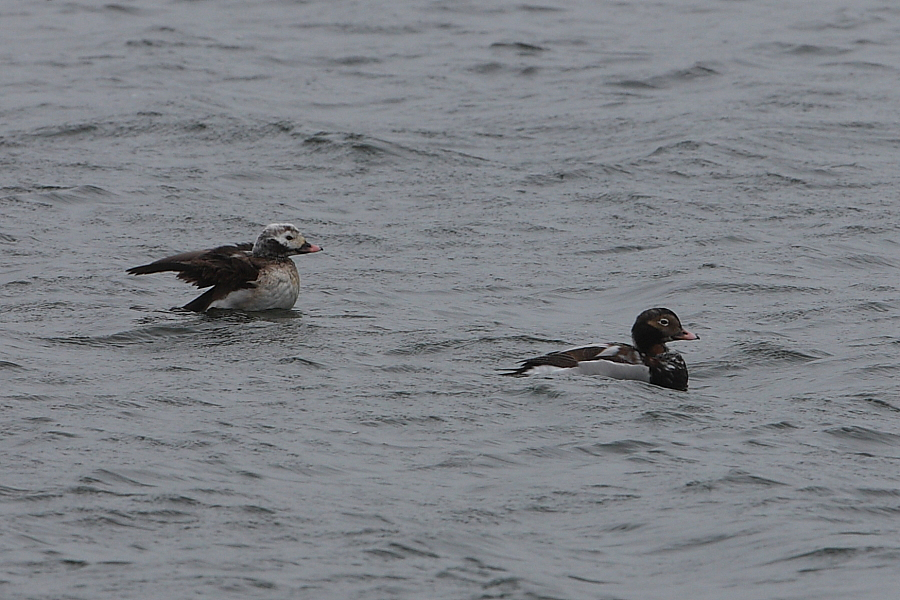
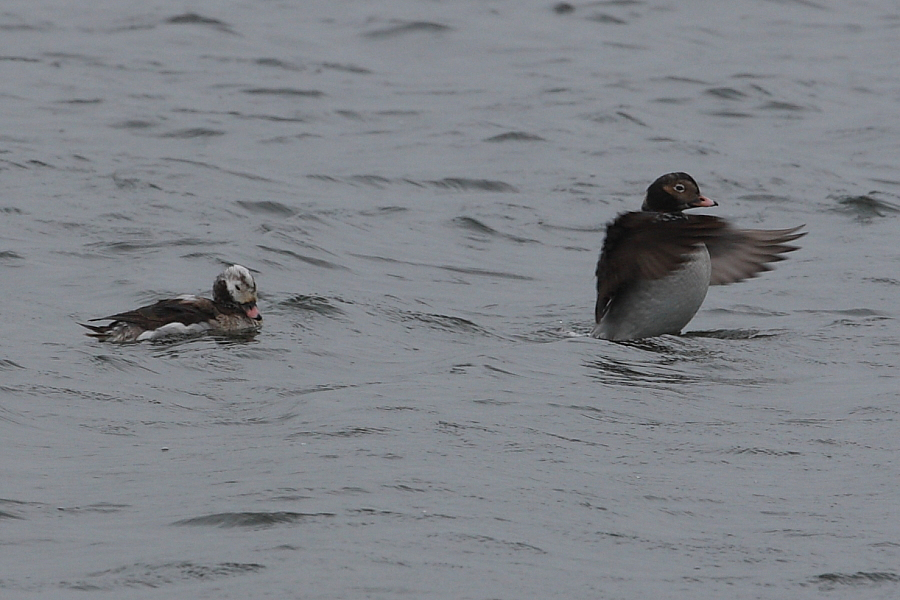
Monday 7th April [Overcast, with a strong breeze and drizzle in the morning. Dry later.]
The 2♂♂ Long-tailed Ducks Clangula hyemalis are still present feeding east of Rainbow Point and the pair of Garganey Anas querquedula were still at Top End this morning. The flock of Sand Martins Riparia riparia and Barn Swallows Hirundo rustica are feeding over the Bell's Bush area and the Common Sandpiper Actitis hypoleucos was on the dam mid-morning too. I counted 5 Willow Warblers Phylloscopus trochilus and saw a lone ♀ Common Goldeneye Bucephala clangula off North Shore. Now't new though!
Tuesday 8th April
No news from the lake today, though Sean Davies texted to say the Long-tailed Ducks had moved to Chew.
I was walking the SWCP again from Lamorna Cove along the very rugged stretch to Sennen Cove, a total of 13.7 miles thanks to a rather poorly signposted, and rather cruel, diversion just before Land's End. I came upon a lady who was nest watching (Red-billed) Choughs Pyrrhocorax pyrrhocorax so managed to add them to my walk list having missed them at The Lizard.
Wednesday 9th April
Melanie Patch emailed to say she had seen the Garganey Anas querquedula at Top End. She also saw the hirundine flock at Bell's Bush in the evening and thought there might have been House Martins among them, but couldn't be sure.
John Thorogood also emailed to say "When I pulled off the road by the Wood Bay seat yesterday afternoon and watched 3 Barn Swallows Hirundo rustica fly past I thought my chances of finally seeing Sand Martin this year were really good. But no, despite walking from there to Top End and back, I didn't see another hirundine! Never seem to go on the right days. Chiffchaff Phylloscopus collybita and Blackcap Sylvia atricapillus were the only migrants in song. (Common) Kestrel Falco tinnunculus being chased by Pied Wagtails Motacilla alba yarellii over the dam area. Met four gents in a car who reported 2 Garganey at Top End but by the time I got there, they were hiding; the Garganey, not the gents! The lake looked a picture in the late afternoon sunshine."
I walked from Sennen Cove past Cot Valley and Pendeen Watch, where I've spent many happy hours birding in the past, and packed in at Trevean Cliff, after 12.4 miles. I saw a few more (Red-billed) Choughs Pyrrhocorax pyrrhocorax along the way. The mystery though, is that I have yet to see a Northern Wheatear anywhere along the walk so far. Still, the sun shone and everything was right with the world today! The walk was stunning.
Thursday 10th April
Paul Williams reported a couple of Northern Lapwings Vanellus vanellus flying west, but no sign of the Garganeys.
I had a gruelling but really enjoyable day along the SWCP. I started at Trevean Cliff, where a Peregrine Falcon was sitting on a rock outcrop and didn't seem in the least bit bothered by my being only about 40 metres away. The path was every bit as challenging and, in places exposed, as I'd expected and it took 5 hours to do the 11 miles to St. Ives. The bonus was that I saw a small pod of Common Dolphins and a Grey Seal along the way. After a brief rest and change of shoes and socks I decided to push on to the Old Quay House Inn at the head of the Hayle Estuary (another 2 hours) where after a meal and a couple of lemonades, I saw an Iceland Gull from the car park. Another 16.9 miles covered.
Friday 11th April [Warm and sunny]
What a difference 3 days away makes! Although there's not much change with the birds other than a few extra Common Coot Fulica atra nests, a Northern Lapwing Vanellus vanellus, 2 Common Sandpipers Actitis hypoleucos and the welcome return of the 2♂♂ Long-tailed Ducks Clangula hyemalis off Peg's Point, the spring warmth has encouraged many insects onto the wing and the Green-winged Orchids Anacamptis morio are beginning to show their heads. I saw a couple of dozen spikes in flower. There was a Holly Blue Celastrina argiolus at Ash Tree and a couple of ♂ Orange-tip butterflies Anthocharis cardamines among the 5 species I saw flitting around, and Dark-edged Bee-flies Bombylius major were also visiting flowers behind the Top End hide.
John Thorogood reported a pair of Grey Wagtails Motacilla cinerea at the dam.
Saturday 12th April [Cool and cloudy with a stiff breeze]
I managed to visit late this afternoon and there were white horses racing down the lake. What a contrast to yesterday. I saw the 2♂♂ Long-tailed Ducks Clangula hyemalis between Wood Bay and Rugmoor Points, but the big change were the hundreds of Barn Swallows Hirundo rustica, with a few each of Sand Riparia riparia and House Martins Delichon urbicum over the water.
Sunday 13th April [A sunny day with a cool breeze]
There were 4 Common Sandpipers Actitis hypoleucos on the south end of the dam this evening, and a smaller number of hirundines over the dam end than over the lake yesterday. The 2♂♂ Long-tailed Ducks Clangula hyemalis were off Wood Bay and the pair of elusive Garganey Anas querquedula still in residence, but as Garganey is a Schedule 1 species, I will not continue to report them should they show any signs of breeding. A policy I have pursued at the lake for a number of years.
Tomorrow, I shall be on the SWCP again for a couple of days, so if you have any news to pass on please email me. Thanks.
Monday 14th April
John Thorogood walked at the lake for a couple of hours and saw the 2♂♂ Long-tailed Ducks Clangula hyemalis from Rainbow Point towards the far bank. He also heard Chiffchaffs Phylloscopus collybita, Blackcaps Sylvia atricapilla and a couple of Willow Warblers Phylloscopus trochilus. Thanks John.
I walked the 13.9 miles of the SWCP from the Old Quay House Inn, Hayle, to Portreath with friends Ann and Colin. We saw at least 61 Atlantic Grey Seals on the beach at Mutton Cove east of Godrevy Point.
Tuesday 15th April
No news from the lake today. I visited at dusk but saw nothing of note. I'll look again tomorrow.
I walked 12.6 miles of the SWCP from Portreath to Perranporth in Cornwall. Having seen no Northern Wheatears on the whole walk before today, I saw at least 25 along the cliffs today.
Wednesday 16th April [Sunny and warm]
There's not a great deal to report from my visit today. A Common Sandpiper Actitis hypoleucos was on the dam and of the occasional breeding wildfowl, I saw a pair of Northern Shovelers Anas clypeata and 4 pairs of Gadwall Anas strepera on the lake. Lots of butterflies were on the wing in the sunshine.
Thursday 17th April [Overcast and windy]
The 2♂♂ Long-tailed Ducks Clangula hyemalis were back from their brief visit to Chew, and riding the waves off Peg's Point. I heard my first Reed Warblers Acrocephalus scirpaceus singing (one each in Pipe Bay and Home Bay reeds) and saw 2 broods of Mallards Anas platyrhynchos (5 juvs at Top End reported by Paul Willams last week, and 6 juvs at Orchard Bay). There were also small numbers of hirundines (the 3 usual spp.) ranging around the lake. Last year I'd recorded 100 spp. of bird at the lake by 15th April. This year I'm still well behind as shown on the phenology page.
Good numbers of Early Purple Orchis mascula and Green-winged Orchids Anacamptis morio are flowering now and both should be showing in All Saint's Meadow at the end of Butcombe Bay in the public access area over the Easter period.
Friday 18th April [Sunny and warm]
Although I spent several hours at the lake, it wasn't until the evening when the bat workers who are training to take part in the National Nathusius's Pipistrelle Pilot Study arrived from around the country. We trapped from dusk until 2330 hrs and although it was cold, we caught a Whiskered, 6 Soprano and 2 Nathusius's Pipistrelles.
Saturday 19th April [Sunny and warm]
Again, today we spent most of the day in the classroom as part of the National Nathusius's Pipistrelle Pilot Study, so I wasn't able to spend time birding at the lake. In the evening we went back to do some more trapping along the North Shore and I was able to pick out the 2♂♂ Long-tailed Ducks Clangula hyemalis in Wood Bay with my binoculars. We set harp traps for bats from Top End right along to Butcombe Bay and caught a Whiskered, a Natterer's, 9 Soprano and a single ♂ Nathusius's Pipistrelles.
Sunday 20th April [Rain in the afternoon]
The bat workers all went home at lunchtime today, so I went down to the lake for a look around this afternoon just as it started to rain! There were at least 2 Common Swifts Apus apus among the hirundines over the dam end, but no sign of the Long-tailed Ducks that I could see.
I've posted more information about the National Nathusius's Pipistrelle Pilot Study on the Bat News page.
Monday 21st April [Warm with sunny spells]
We did the WeBS Count today and started with 4 Common Swifts Apus apus among a small group of hirundines over the dam end, where we also saw 2 Common Sandpipers Actitis hypoleucos and the juvenile/1st-winter Great Black-backed Gull Larus marinus yellow 'D:AG' that has spent the winter on Blagdon and Chew. We heard 5 singing Sedge Warblers Acrocephalus schoenobaenus along the south side of the lake and saw the 2♂♂ Long-tailed Ducks Clangula hyemalis, which showing very well in Holt Bay when we left early afternoon. Full details of the count can be seen on the WeBS Page.
Tuesday 22nd April [Sunny spells and heavy showers]
The showers didn't appear to drop any migrants other than hirundines this morning. The 2♂♂ Long-tailed Ducks Clangula hyemalis were in Holt Bay when I arrived, but had moved around to Wood Bay by the time I left. There were 2 Common Sandpipers Actitis hypoleucos on the dam.
I've seen a number of St. Marks Fly (aka Hawthorn Fly) Bibio marci on the wing in the last couple of days.
Wednesday 23rd April [Drizzle in the morning, dry later.]
I first saw the 2♂♂ Long-tailed Ducks Clangula hyemalis in flight today, but at lunchtime they were back in Holt Bay, where I inadvertently flushed a couple of Common Snipe Gallinago gallinago. The latest date I have for Long-tailed Ducks at the lake is 27th April 2000, so we can reasonably expect them to leave any day now. Along the north shore I heard my first Garden Warbler Sylvia borin, 2 Lesser Whitethroats Sylvia curruca and a single Common Whitethroat Sylvia communis singing, and on the south side 2 Sedge Warblers Acrocephalus schoenobaenus were trying to outdo each other at Wood Bay. I saw 3 Common Sandpipers Actitis hypoleucos in flight together, but there may have been as many as 8 present. The hirundine flock contained at least 2 Common Swifts Apus apus and, rather unexpectedly, 4 Black-headed Gulls Chroicocephalus ridibundus flew through to the east, and 2 Common Goldeneye Bucephala clangula (1st-winter ♂, and a ♀) were also noted during my visit.
Thursday 24th April [Dry with showers late afternoon]
I spent most of the day working on the ducks section of the forthcoming Avon Bird Report, so it was a blessed relief to get out this evening after the rain showers. The 2♂♂ Long-tailed Ducks Clangula hyemalis and the pair of Common Goldeneye Bucephala clangula were asleep between Rugmoor and Wood Bay Points. The Long-tails didn't stir the whole time I was at the lake. Perhaps they were preparing themselves for the long flight to the Arctic tundra tonight?
While I was standing on Rainbow Point, a ♂ Common Cuckoo Cuculus canorus sang out from somewhere along the south side of the lake between Holt Copse and Top End; the first I've seen, or heard, at the lake since 2007 and a fantastic way to bring my 'patch' tally to 100 bird species this year. But that was just the start... The last hour of daylight was absolutely magical. There wasn't a breath of wind, the lake was like a mirror and, as the temperature dropped, mist started rolling off the fields down the valley, over the lakeside hedges, and out over the water. While Blackbirds serenaded the setting sun, the only thing missing was the bouyant, twisting flight of a Barn Owl hunting among the Roe Deer in the meadows - that would have been perfection. Nevertheless, when the first Tawny Owl called, I made my way home feeling as happy as Larry. What wonderful therapy for the hurly-burly of modern life!
Friday 25th April [Overcast and murky with steady, light, rain around lunchtime.]
The 2♂♂ Long-tailed Ducks Clangula hyemalis were still present at lunchtime off Rainbow Point, before flying towards the North Shore. At Top End, an hour sitting in the hide produced a 1st-summer Little Gull Hydrocoloeus minutus from about 1300-1340 hrs. Surprisingly, given the conditions, there were only a few hirundines hawking over Bell's Bush. There was no sign of the Cuckoo heard yesterday.
Joanna Dailey emailed me this morning: "Yesterday, YA’s mate produced their first egg! YA, hero that he is, did most of the morning incubation including an hour in the rain." See Joanna's Kielder Ospreys Blog for lots more pictures, video clips and daily updates as family life gets underway.
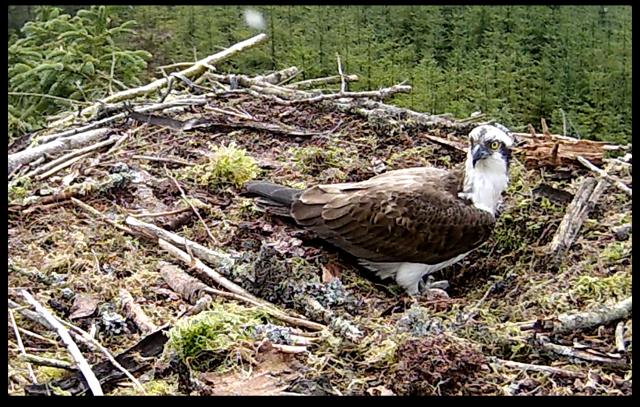 Osprey YA with the pairs first egg of the season, Kielder Water © Forestry Commission England, 2014
Osprey YA with the pairs first egg of the season, Kielder Water © Forestry Commission England, 2014
Saturday 26th April [Sunshine and showers]
I saw the 2♂♂ Long-tailed Ducks Clangula hyemalis off Rainbow Point with Rich Andrews today, but had no time to look for anything else.
I have been doing a bit of reading about the moult of Long-tailed Ducks in the Handbook of the Birds of Europe the Middle East and North Africa Vol. 1 which describes their plumage changes as "complex and controversial". Indeed, some observers, given brief and distant views, thought that they were probably a pair when they arrived, but careful observation showed that both had pink bill bands even though they wore different plumages. It seems that drakes develop the pink band on their bills from October onwards, so we can confidently say that both are indeed drakes, but in mid-March this doesn't help us with ageing them. I grabbed a couple of long distance photos that showed one to resemble a normal winter drake with white head and dark cheek patch, whilst the other showed more juvenile features though, crucially, neither had a long tail. I reasoned that both were likely to be 1st-winters or immatures because adults would probably have long tails, but needed to check references. Well, what are the moult sequences of drake Long-tailed ducks? Essentially, there are four adult moult periods per year that can be described as (1) spring moult in April and May, (2) summer moult from late June to early September, (3) autumn moult from mid-September to early October, and, (4) winter moult from late October to mid-November, and it is during the summer moult that an adult drake moults its tail. Therefore, we would expect an adult drake visiting the lake in March through April to have a long tail which, as I've said, these birds don't have. So, they can be described as immature drakes, but that raises the question of how long do they remain in immature plumage; one, two, or more, years? Diving back into the Handbook, it says of the post-juvenile and immature autumn and winter moults "Partial; September-December. Amount of plumage involved markedly variable; tends to follow equivalent moults of adult. Involves flanks, head and neck, and part of the chest, upper mantle and scapulars. Retarded specimens retain almost complete juvenile plumage until spring; advanced attain winter plumage, except for breast, belly, vent and outer tail feathers." This suggests that one bird could be an advanced individual and the other more retarded with respect to their winter moults. Both have been undergoing significant changes in the last couple of weeks, consistent with an immature spring moult, in that "part of immature winter plumage and juvenile wing, underparts, and outer or all tail retained." The Handbook then says that during the immature summer moult from mid-July onwards the last juvenile feathers, including the tail and wing will be lost. So, I conclude that they are 1st-winter ♂♂ that are currently undergoing their immature spring moult, and that the differences in plumage noted on their arrival was consistent with one attaining a more advanced immature winter moult than the other. They are beginning to resemble one another more closely in the last two weeks.
Sunday 27th April [Miserable and wet all day]
The 2♂♂ Long-tailed Ducks Clangula hyemalis were asleep at Orchard Bay this afternoon and the only other bird worthy of note was a Little Egret Egretta garzetta in flight at Bell's Bush.
Monday 28th April [Mild, still and murky]
The 2♂♂ Long-tailed Ducks Clangula hyemalis were feeding in Wood Bay and today have become the latest ever recorded at the lake, according to my records. I spent 3 hours walking there this morning and aside from a Common Shelduck Tadorna tadorna and a Common Sandpiper Actitis hypoleucos there wasn't much else on the water to quicken the pulse. I counted a few species of warbler: 20 Blackcaps Sylvia atricapilla, 16 Chiffchaffs Phylloscopus collybita, 4 Garden Warblers Sylvia borin, 4 Common Whitethroats Sylvia communis, 4 Sedge Warblers Acrocephalus schoenobaenus and 2 Lesser Whitethroats Sylvia curruca. 2 Common Swifts Apus apus flew overhead at Pipe Bay and I spotted a Great Black-backed Gull Larus marinus with a green darvic 'L42' standing on a buoy - this is one that turned up from Normandy in France for the first time last year.
Tuesday 29th April [Warm and mainly overcast]
It took a little while to spot them late this afternoon, but the 2 immature ♂♂ Long-tailed Ducks Clangula hyemalis were still present, feeding off Peg's Point. Rather unusually, there was a lone, seemingly rather agitated, Barnacle Goose Branta leucopsis on the lake as well.
Earlier this afternoon, many local birders went to the funeral of Andy Davis's wife, Gill, who tragically died in the prime of her life. Our thoughts go out to Andy and family at this difficult time.
White YA, the ♂ Osprey Pandion haliaetus who graced us with his presence last spring, and his partner, have another egg in their nest at Kielder Water. Joanna Dailey wrote "The female laid her second egg at 16.02 yesterday. Unfortunately, YA hadn’t come back from (presumably) a fishing trip when the camera stream went off just after 17.00 so no pic of him admiring it yet. It is an incredibly long gap between eggs; the osprey statisticians I’m in touch with can’t find another UK one over 100 hours from data from known sites like ours. About 75 hours is the normal maximum. A record for Kielder, maybe!" See Joanna's Kielder Ospreys Blog for pictures and video of Mrs YA laying the second egg. Amazing!
Wednesday 30th April [Misty early then sunny and warm]
The 2 immature ♂♂ Long-tailed Ducks Clangula hyemalis have made it until the end of the month and were feeding off Peg's Point this morning, despite the all boat anglers fishing in the Top End basin. I spent some 3.5 hours looking around and heard a new Lesser Whitethroat Sylvia curruca on the south side of the lake, saw 6 Common Swifts Apus apus with some hirundines at Long Bay, and heard my first House Sparrow Passer domesticus by the lake this year in the hedge at Holt Bay, where I think the farm birds come to forage for insects to feed their young during the spring and summer. And, talking of young birds, there was a third brood of Mallard Anas platyrhynchos (♀ and 1 juvenile) at Cheddar Water.
I noted three Marsh Orchid Dactylorhiza sp. spikes starting to flower at Top End and a Green-winged Orchid Anacamptis morio spike at Holt Bay, the first I've recorded at this location lakeside. I also saw my first ♀ Oil Beetle Meloe sp. (likely to be Violet Oil Beetle Meloe violaceus) of the year on the road at Bell's Bush.
It was nice to meet a group of ladies bird watching at the Hatchery entrance, though I'm sorry there wasn't a great deal to see or hear, other than the regular Mill House garden birds.
I won't be reporting from the lake over the next couple of days because I'll be back on the South West Coast Path. Any reports from the lake will be gratefully received and passed on, especially of the Long-tailed Ducks if they stay into May.